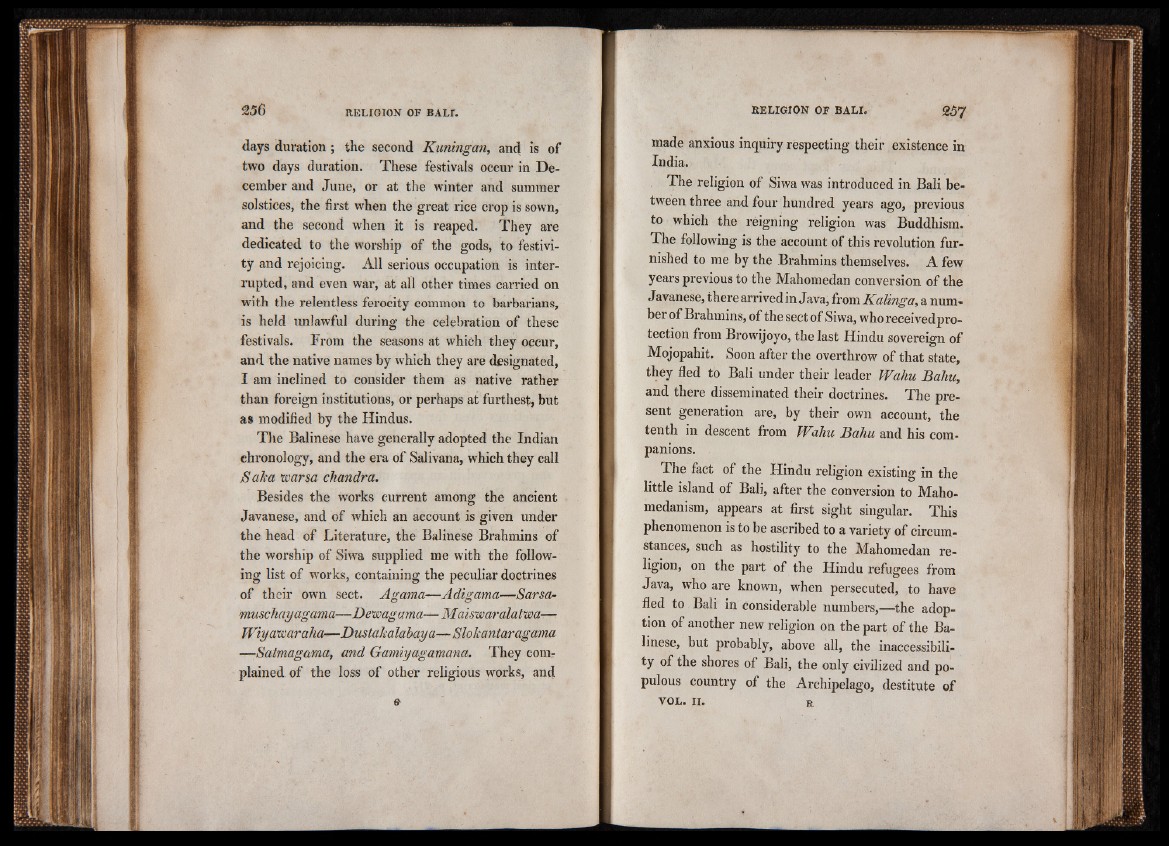
days duration ; the second Kuningan, and is of
two days duration. These festivals occur in December
and June, or at the winter and summer
solstices, the first when the great rice crop is sown,
and the second when it is reaped. They are
dedicated to the worship of the gods, to festivity
and rejoicing. All serious occupation is interrupted,
and even war, at all other times carried on
with the relentless ferocity common to barbarians,
is held unlawful during the celebration of these
festivals. From the seasons at which they occur,
and the native names by which they are designated,
I am inclined to consider them as native rather
than foreign institutions, or perhaps at furthest, but
as modified by the Hindus.
The Balinese have generally adopted the Indian
chronology, and the era of Salivana, which they call
S aka warsa chandra.
Besides the works current among the ancient
Javanese, and of which an account is given under
the head of Literature, the Balinese Brahmins of
the worship of Siwa supplied me with the following
list of works, containing the peculiar doctrines
of their own sect. Agama—Adigama—Sarsa-
muschayagama—Dewagama—Mais'waralat’wa—■
Wiyawaraha—Dustakalabaya—Slokantaragama
—-Satmagama, and Gamiyagamana. They com?
plained of the loss of other religious works, and
&
made anxious inquiry respecting their existence in
India.
The religion of Siwa was introduced in Bali between
three and four hundred years ago, previous
to which the reigning religion was Buddhism.
The following is the account of this revolution furnished
to me by the Brahmins themselves. A few
years previous to the Mahomedan conversion of the
Javanese, there arrived in Java, from Kalinga, a number
of Brahmins, of the sect of Siwa, whoreceivedpro-
tection from Browijoyo, the last Hindu sovereign of
Mojopahit. Soon after the overthrow of that state,
they fled to Bali under their leader Wahu Baku,
and there disseminated their doctrines. The present
generation are, by their own account, the
tenth in descent from Wahu Bahu and his companions.
The fact of the Hindu religion existing in the
little island of Bali, after the conversion to Maho-
medanism, appears at first sight singular. This
phenomenon is to be ascribed to a variety of circumstances,
such as hostility to the Mahomedan re-
ligion, on the part of the Hindu refugees from
Java, who are known, when persecuted, to have
fled to Bali in considerable numbers,—the adoption
of another new religion on the part of the Balinese,
but probably, above all, the inaccessibility
of the shores of Bali, the only civilized and populous
country of the Archipelago, destitute of
VO L. II. r